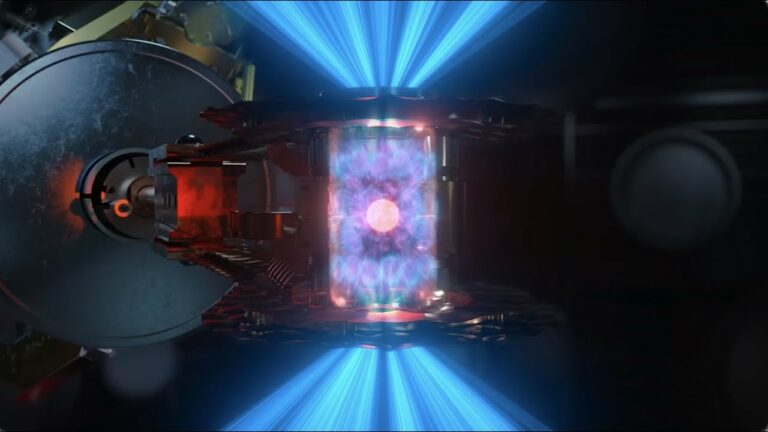Major breakthrough in pursuit of nuclear fusion unveiled by US scientists
A nuclear fusion experiment produced more energy than it consumed.
Although significant obstacles still stand in the way of nuclear fusion-based energy production, American researchers have made a significant advancement.
Nuclear fusion is an energy-producing process that transforms basic atomic nuclei into more complex ones, for example, joining hydrogen atoms to create helium. When enormous volumes of molecular dust collide under gravity and produce enormous pressures and temperatures in the centres of young stars, nuclear fusion occurs.
Therefore, nuclear fusion has been the goal of sustainable energy generation for decades, but scientists have not succeeded in attaining it. However, a group from the California-based Lawrence Livermore National Laboratory (LLNL) may have finally achieved a significant step toward producing energy-producing “stars” within reactors.
The National Ignition Facility (NIF) has purportedly achieved fusion ignition thanks to a team from LLNL, according to a statement(opens in new tab) released Tuesday (Dec. 13). The first controlled fusion experiment to achieve this milestone, also known as scientific energy breakeven, or the production of more energy from fusion than the laser energy used to drive it, was carried out on December 5 by a team at LLNL’s National Ignition Facility (NIF), according to the statement.
In the experiment, 192 lasers were used to blast a fuel pellet the size of a pencil eraser, forcing the particle to then release additional energy. According to the release from LLNL, the experiment “surpassed the fusion threshold by sending 2.05 megajoules (MJ) of energy to the target, resulting in 3.15 MJ of fusion energy production, establishing for the first time a most fundamental physics underpinning for inertial fusion energy (IFE).”
LLNL warns that this does not, however, imply that fusion power is feasible. “To attain easy, inexpensive IFE to power homes and businesses, several sophisticated scientific and technological advancements are still required, and [the U.S. Department of Energy] is presently resuming a broad-based, coordinated IFE initiative in the United States. There is a lot of impetus to propel rapid progress toward fusion commercialization when combined with private sector investment “The statement keeps going.
Although this is simply a first step in the process of using fusion energy for clean energy, LLNL executives are praising the success as a paradigm-shifting achievement. At the news conference on Tuesday, LLNL Director Dr. Kim Budil remarked, “Ignition is a first step, a really significant one that sets the stage for a revolutionary decade in high-energy density physics and fusion research. I cannot wait to see where it takes us.”
The obstacles in science and technology standing in the way of fusion energy are formidable. But when we make the seemingly impossible doable, that’s when we excel, said Budil. “
Such circumstances can cause the fusion process to start, but in the current experiment, it was only sustained for a relatively little time. The experiment reached a milestone known as net energy gain when the energy produced by the fusing atoms exceeded the energy needed by the lasers sparking the reaction.
The laboratory’s researchers have recently carried out a number of fusion tests, but they haven’t produced enough energy to qualify as a significant advance. The group generated almost as much energy in 2014 as a 60-watt light bulb uses in five minutes. They succeeded in producing 10 quadrillion watts of power last year, which was almost 70% more energy than the experiment used.
The most recent experiment produced a tiny bit more energy than it used, indicating that the reaction may have been able to sustain itself for a limited period of time by fusing more hydrogen atoms with its own energy rather than relying on the lasers’ heat.
According to The Guardian, the experiment only yielded 0.4MJ of net energy gain, which is only enough to boil a pot of water.
The development comes as the globe tries to find new sustainable methods to meet its energy demands without relying on burning fossil fuels while simultaneously coping with a global energy crisis brought on by Russia’s conflict with Ukraine. In addition to being free of carbon emissions, fusion energy is also devoid of radioactive waste, a feared result of nuclear fusion.
The experiment, while encouraging, is merely the first stage in a long process leading to the employment of nuclear fusion in industry, the New York Times warns. Both the technology required to transform the nuclear fusion reaction’s produced energy into electricity as well as lasers effective enough to initiate and maintain nuclear fusion on an industrial scale have not yet been created.
The National Ignition Facility employed an unconventional technique to start the fusion reaction in its research, which are largely focused on enabling nuclear weapon testing without real nuclear explosions.
The majority of nuclear fusion attempts use tokamaks, which are ring-shaped special reactors that contain hydrogen gas. Plasma is created when the hydrogen gas within the tokamak is heated to the point at which its electrons separate from the atomic nuclei.
The cylinder was heated by the lasers to a temperature of around 5.4 million degrees Fahrenheit, at which point it melted and released an X-ray burst. A tiny pellet of frozen deuterium and tritium, two hydrogen isotopes, was then cooked by these X-rays. In the first glimpse of nuclear fusion, the hydrogen atoms in the pellet’s core combined to form helium as it heated up.
Do not forget to share your opinion with us to provide you with the best posts !




0 Comments